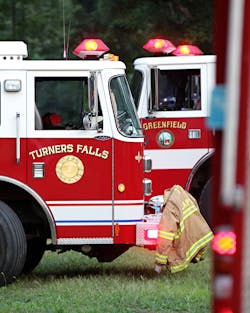Download the full PDF of the supplement here.
Fire chiefs have to consider several factors when purchasing new apparatus—capabilities, effectiveness, appropriateness and budgetary considerations. In addition, many will ask themselves how the purchase will affect their community’s ISO Public Protection Classification (PPC) rating. What effect will the new apparatus have, if any? Are they buying too much? Not buying enough?
Basic business
To clarify the process that ISO uses to review fire apparatus, let’s start with two basics. First and foremost, fire chiefs should conduct a risk assessment of the community to guide resource-acquisition decisions. Next, chiefs should have a general understanding of the PPC evaluation process for apparatus so they know how their purchase will affect the rating.
PPC evaluates four primary categories of fire protection services in a community: the fire department, water supply, emergency communications, and community risk reduction. The tool that ISO uses is the Fire Suppression Rating Schedule (FSRS), which follows certain standards set by the National Fire Protection Association (NFPA). In evaluating apparatus, ISO analyzes its use and reviews to see if the equipment meets minimum survey requirements.
Apparatus grading process
The evaluation of the fire department accounts for 50 of the 105.5 points available in the total PPC grading. It’s based on the fire department’s first-alarm response and initial attack to minimize potential loss. ISO reviews such items as engine companies, ladder or service companies, deployment of fire companies, equipment carried on apparatus, pumping capacity, reserve apparatus, company personnel, and training.
When it comes to evaluating fire engines, ISO relies on NFPA 1901: Standard for Automotive Fire Apparatus. The main items reviewed include tank capacity, pump size, quantity of attack and supply hose, and pump and hose testing. There’s no age limit for an engine, and as long as it meets minimum requirements, the engine can be used in the grading. The analysis of the pump test program and hose test program—if a department does those processes annually—can account for 25 percent of total engine points.
There isn’t an age standard for ladder trucks either. A ladder truck can have a straight stick or an aerial platform, rear-mounted or mid-ship. It should be equipped with ground ladders and other ladder company operations equipment. ISO reviews the ladder test program, which includes an annual destructive test and a 5-year nondestructive test. The aerial device should be as tall as the highest building in the community, up to 100 feet. For example, if the community has a seven-story building, the department needs an aerial device of 75 feet or higher. If the community has a 15-story building, height of the aerial is capped at 100 feet.
Many departments ask about the meaning of the term “service truck.” A service truck is a ladder truck without an aerial device. It can carry ladder company operations equipment similar to a ladder truck, such as ground ladders, ventilation fans, rescue tools, a generator and lights. As to whether a fire department needs a ladder truck or a service truck, the answer depends upon the number of buildings three stories or higher and whether needed fire flows (NFF) are greater than 3,500 gallons per minute.
For communities that haul water or use alternative water supply sources, ISO reviews tankers in these operations. ISO credits apparatus based on the community’s needs, which are determined by its basic fire flow or how the fire department operates. If the survey reveals the community requires two fire engines, ISO expects the community to maintain two, and they can be housed in separate fire stations. Additional fire engines and ladder/service trucks can receive credit as reserve units. Reserve need is based on the amount of in-service apparatus. Automatic-aid fire engines and ladder/service trucks can meet the requirement for trucks in a community. The review defines automatic as aid dispatched to all reported structural fires every time, all year round, and it must meet ISO minimum requirements.
Finally, the equipment on the apparatus is also a factor. ISO evaluates that equipment and follows the recommendations for equipment outlined in NFPA 1901.
For more
To learn more about ISO community hazard mitigation, PPC and the FSRS, visit isomitigation.com.
About the Author

Joseph W. Fratantaro
Joseph W. Fratantaro is a Community Hazard Mitigation manager at ISO, a member of the Verisk Insurance Solutions Underwriting Group at Verisk Analytics. He has been with ISO for 18 years and was a principal member of the Fire Suppression Rating Schedule (FSRS) revision team. He has 36 years’ experience in emergency services and was the fire training coordinator for the Bucks County, PA, Emergency Services Training Center. He is a certified Fire Service Instructor and Fire Company Officer.
